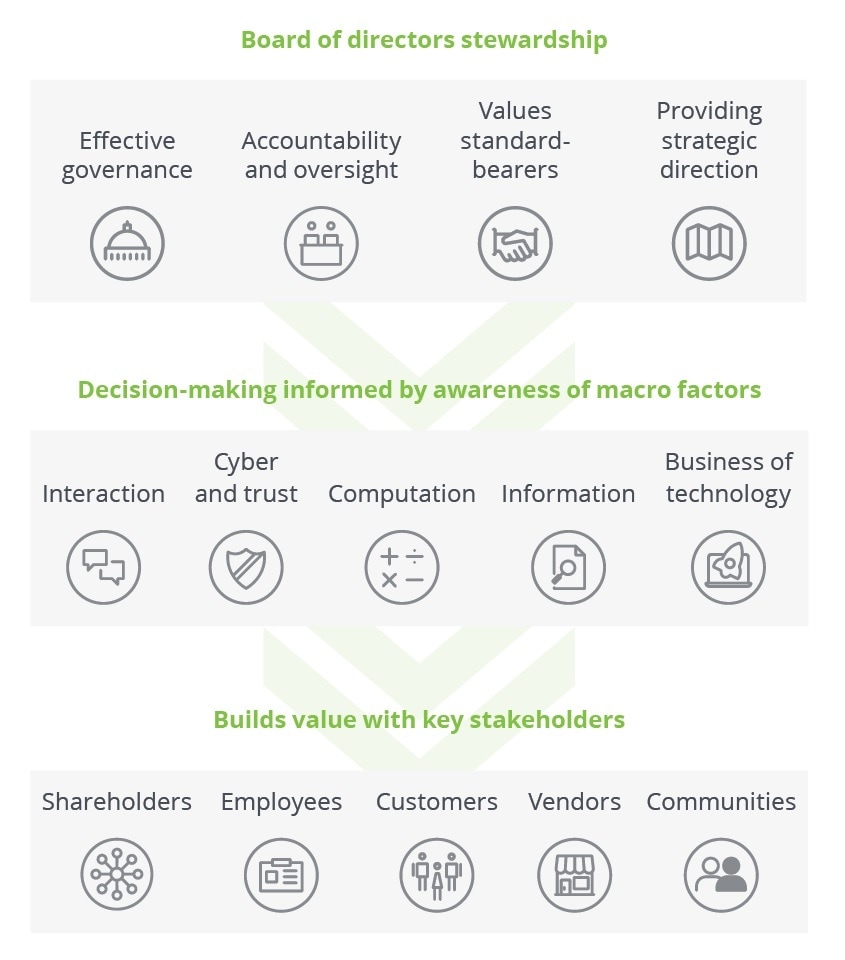Rethinking how tech trends shape governance and oversight has been saved

Perspectives
Rethinking how tech trends shape governance and oversight
On the board’s agenda, February 2023
By Carey Oven and Mike Bechtel
Introduction
The corporate board has many stakeholders—shareholders,1 employees, vendors, customers, and communities.2 Being responsive to such a wide array of constituencies is no easy task. Over time, technology has become an omnipresent concern across these groups. And thus, technology has likewise become a recurring topic of concern to boards.3 The rise of the digital age has brought with it a mix of both opportunities and threats. On the one hand, the high-tech revolution has improved economies of scale and transformed business processes across every industry sector.4 Conversely, the boon of technologically aided abundance has brought with it increasing economic inequities, regulatory scrutiny, and rising consumer distrust.5
For board members, making informed governance decisions in this area is more challenging than ever before.6 This is partially because the complexity of enterprise technology is increasing at an exponential rate.7 Deloitte’s 2023 Tech Trends report offers a navigational framework for boardroom conversations in this area.8 Specifically, the report suggests a holistic governance approach where leverage of technology is based on the business use case rather than its perceived novelty or innovativeness.9 To put it simply: The best way to drive a nail is determined by the size, dimensions, and materials of the nail—not the newness of the hammer. That remains true even if it’s an “enterprise smart hammer,” which connects to your smartphone and provides voice-guided assistance.
What does it mean to have ‘effective’ technology governance?
Deloitte’s analysis shows how the ever-changing technology landscape is being driven by a mix of macro-level innovational and foundational forces.10 Interaction, information, and computation are the innovations that have shaped nearly every paradigm change in technology. Notably, these are the basic structural forces behind every major technology innovation in the modern business era—from the first general-purpose computer to the metaverse.11 Underlying this are three foundational forces: the business of technology, cyber and trust, and core modernization. Taken together, these six macro forces can serve as guideposts for how technology trends are shaping stakeholder expectations.
Guideposts for technology-informed governance strategies
|
Importantly, these six forces are more than simple expressions of specific and discrete technologies or platforms. After all, the current vessels of innovation—which for 2023 includes artificial intelligence, the metaverse, and blockchain—are always changing. Being a technical expert in any specific platform or emerging trend may certainly be helpful, but for boards, a broader purview may be needed. These six innovational and foundational factors offer a way to better understand the needs of board stakeholders, especially in terms of how they interact with the digital world around them.12 The below chart outlines how keeping these drivers of technology trends in mind can inform the governance process.
How drivers of technology innovation can add value
|
What does a technology-informed governance strategy look like?
In recent decades, the amount of time boards devote to technology and the enterprise has been on the rise.13 And according to research conducted by the Center for Board Effectiveness and Columbia University’s Millstein Center for Global Markets and Corporate Ownership, that trend is only expected to accelerate.14 As technology issues have become more complex and multifaceted, there is an understandable tendency to compartmentalize them.15 For example, technology is frequently discussed only in the context of risk management or information security.16
One timely example of boards balancing growing priorities is the SEC’s upcoming rules on cybersecurity.17 Dialogue on the proposed regulations has revolved around the technical requirements. Among the most pressing concerns is how corporations will show board cybersecurity expertise via SEC filings. These proposed requirements may increase compliance obligations,18 so focusing on such details is unquestionably important. However, it may also be helpful to view the issue through the lens of technology trends. Because at its core, research suggests the SEC’s regulation changes may reflect an institutional response to growing public trust gaps—another issue noted in Deloitte’s 2023 Tech Trends report.19
It is perhaps cliché to note that every company is a technology company. But a growing body of evidence shows a link between proactive technology governance strategies and performance.20 For that reason, technology trends are likely to remain at the top of the board’s agenda for 2023, and beyond. Regardless of the challenge—be it an evolving regulatory framework for cybersecurity or the changing way stakeholders’ interface with the digital world—the coming years may require a fundamental reframing of technology issues. There are clear benefits to such reframing, because doing so could foster a more agile and forward-looking governance culture.21 In that vein, the below might act as a starting point for navigating boardroom technology discussions.
Reframing board connections between technology and enterprise
|
What questions can guide boardroom discussions in this area?
The innovation du jour at the start of 2023 is, undoubtedly, already changing. But regardless of form, technologically informed governance can help both mitigate risk and enhance a company’s competitive advantage. Questions to consider in this area include:
- Is the technology strategy consistent with the company’s values on inclusivity and equity? Are there checkpoints to ensure these values are kept in mind at every point in management’s decision-making process?
- What is the strategy to proactively monitor the opportunities and threats that arise due to changes in the technology landscape?
- What is the process to determine whether an innovation is worthy of pursuing and incorporating into the business process?
- Is the proposed adoption of a new technology solving a priority issue in a manner congruent with the organization’s strategic plan?
- What are the risks and liabilities that could occur due to using (or not using) a particular technology?
- Beyond technology executives, what other internal stakeholder input is needed to ensure a holistic strategy in this area? When should external stakeholder input be gathered?
- How might the decision to use (or not use) an innovation improve (or degrade) trust relationships across the board’s stakeholders?
Endnotes
1 Jeffrey Pfeffer, “Shareholders first? Not so fast…,” Harvard Business Review, July–August 2009.
2 George Serafeim, “Investors as stewards of the commons?,” Journal of Applied Corporate Finance 30, no. 2 (2018): pp. 8–17, https://doi.org/10.1111/jacf.12294.
3 Peter Weill et al., “It pays to have a digitally savvy board,” MIT Sloan Management Review 60, no. 3 (Spring 2019): pp. 41–45; Stephen Andriole, “Boards of directors and technology governance: The surprising state of the practice,” Communications of the Association for Information Systems 24, no. 1 (March 1, 2009), https://doi.org/10.17705/1CAIS.02422.
4 Jeffrey T. Macher and Christopher S. Boerner, “Experience and scale and scope economies: Trade-offs and performance in development,” Strategic Management Journal 27, no. 9 (2006): pp. 845–65, https://doi.org/10.1002/smj.540.
5 Linda M. Sama, Abraham Stefanidis, and R. Mitch Casselman, “Rethinking corporate governance in the digital economy: The role of stewardship,” Business Horizons 65, no. 5 (September 1, 2022): pp. 535–46, https://doi.org/10.1016/j.bushor.2021.08.001; Ira Kalish, Michael Wolf, and Jonathan Holdowsky, “The link between trust and economic prosperity: Repairing global erosion of trust has economic advantages,” Deloitte Insights, May 20, 2021; Jessica Kosmowski and Paul Silverglate, “Beyond good intentions: Navigating the ethical dilemmas facing the technology industry,” Deloitte, October 27, 2021, https://www2.deloitte.com/us/en/insights/industry/technology/ethical-dilemmas-in-technology.html.
6 Elizabeth L. H. Valentine and Glenn Stewart, “The emerging role of the board of directors in enterprise business technology governance,” International Journal of Disclosure and Governance 10, no. 4 (November 1, 2013): pp. 346–62, https://doi.org/10.1057/jdg.2013.11; Swarnodeep Homroy and Aurelie Slechten, “Do board expertise and networked boards affect environmental performance?,” Journal of Business Ethics 158, no. 1 (August 1, 2019): pp. 269–92, https://doi.org/10.1007/s10551-017-3769-y.
7 Aneel Chima and Ron Gutman, “What it takes to lead through an era of exponential change,” Harvard Business Review, October 29, 2020; Carlos Agostinho et al., “Towards a sustainable interoperability in networked enterprise information systems: Trends of knowledge and model-driven technology,” Computers in Industry, Special Issue on Future Perspectives On Next Generation Enterprise Information Systems, 79 (June 1, 2016): pp. 64–76, https://doi.org/10.1016/j.compind.2015.07.001.
8 Mike Bechtel and Bill Briggs, “Tech Trends 2023,” Deloitte Insights, 2023.
9 Ryan Peterson, “Crafting information technology governance,” Information Systems Management 21, no. 4 (September 2004): pp. 7–22, https://doi.org/10.1201/1078/44705.21.4.20040901/84183.2.
10 Mike Bechtel and Bill Briggs, “Tech Trends 2023,” Deloitte Insights, 2023.
11 Leif van Neuss, “The drivers of structural change,” Journal of Economic Surveys 33, no. 1 (February 2019): pp. 309–49, https://doi.org/10.1111/joes.12266.
12 Zyad Alreemy et al., “Critical success factors (CSFs) for information technology governance (ITG),” International Journal of Information Management 36, no. 6, Part A (December 1, 2016): pp. 907–16, https://doi.org/10.1016/j.ijinfomgt.2016.05.017.
13 Miriam Schwartz-Ziv and Michael S. Weisbach, “What do boards really do? Evidence from minutes of board meetings,” Journal of Financial Economics 108, no. 2 (May 1, 2013): pp. 349–66, https://doi.org/10.1016/j.jfineco.2012.04.011.
14 Center for Board Effectiveness and Ira M. Millstein Center for Global Markets and Corporate Ownership, The future of board time and priorities, Deloitte and Columbia Law School, 2022.
15 Sarah Bartholomeusz, “Lead your company away from fear of technology,” Governance Directions 68, no. 7 (n.d.): pp. 394–6, https://doi.org/10.3316/informit.289405753807959.
16 Nishani Edirisinghe Vincent, Julia L. Higgs, and Robert E. Pinsker, “Board and management-level factors affecting the maturity of IT risk management practices,” Journal of Information Systems 33, no. 3 (September 1, 2019): pp. 117–35, https://doi.org/10.2308/isys-52229; Lawrence J. Trautman and Kara Altenbaumer-Price, “The board’s responsibility for information technology governance,” Journal of Computer & Information Law 28, no. 3 (2011): p. 313.
17 Cybersecurity Risk Management, Strategy, Governance, and Incident Disclosure, 87 FR 16590, (March 23, 2022).
18 Caroline C. Hartmann and Jimmy Carmenate, “Academic research on the role of corporate governance and IT expertise in addressing cybersecurity breaches: Implications for practice, policy, and research,” Current Issues in Auditing 15, no. 2 (April 21, 2021): pp. A9–23, https://doi.org/10.2308/CIIA-2020-034.
19 Brad Lunn, “Strengthened director duties of care for cybersecurity oversight: Evolving expectations of existing legal doctrine,” Journal of Law & Cyber Warfare 4, no. 1 (2014): pp. 109–37.
20 Rich Nanda et al., “A new language for digital transformation,” Deloitte Insights, September 23, 2021; Ofir Turel, Peng Liu, and Chris Bart, “Board-level information technology governance effects on organizational performance: The roles of strategic alignment and authoritarian governance style,” Information Systems Management 34, no. 2 (April 3, 2017): pp. 117–36, https://doi.org/10.1080/10580530.2017.1288523.
21 Shelly Ping-Ju Wu, Detmar W. Straub, and Ting-Peng Liang, “How information technology governance mechanisms and strategic alignment influence organizational performance: Insights from a matched survey of business and IT managers,” MIS Quarterly 39, no. 2 (2015): pp. 497–518.
Recommendations
On the Board's Agenda
Top of mind topics for board members
The 2023 board agenda
On the board’s agenda, January 2023






